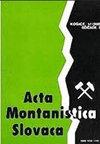活化后赤泥和黑镍泥结构的变化
IF 2.2
4区 地球科学
Q2 GEOSCIENCES, MULTIDISCIPLINARY
引用次数: 0
摘要
本文涉及对金属生产过程中产生的某些危险废物的结构进行评估,即铝生产过程中产生的废物--赤泥和镍生产过程中产生的废物--黑镍泥。在环境应用中,赤泥和黑镍泥在活化后可能会被使用。使用盐酸对样品进行活化,以研究处理前后的结构特性。这两种废物都具有适当的吸附和催化特性,其表面活化可对其产生积极影响。样品的形态由扫描电子显微镜进行记录,相分析由衍射技术进行,元素含量由 EDX 分析进行测定。此外,还对样品进行了傅立叶变换红外分析。活化可增加样品的比表面积,这在许多环境应用中都是有益的,如吸附去除污染物。对样品的处理会改变吸附剂的表面特性,如静电、疏水和亲水特性。活化会产生新的表面结构,从而影响其特性。电离辐射 X 分析证实了铁、铝、硅和钛的高含量,这些元素具有良好的吸附和催化特性。X 射线衍射图显示,活化后废物的结构仅发生了轻微变化。扫描电子显微镜(SEM)的结果证实了表面结构的变化,以及成功吸附过程所需的新活性中心的产生。傅立叶变换红外光谱分析确定了样品结构的变化主要是由于 C=O 和 O-Si-O 键的热降解造成的。本文章由计算机程序翻译,如有差异,请以英文原文为准。
Changes in the structure of red mud and black nickel mud after activation
This paper deals with the evaluation of the structure of selected hazardous wastes from the production of metals, namely waste from the production of aluminium - red mud and waste from the production of nickel - black nickel mud. In environmental applications, red mud and black nickel mud are likely to be used after activation. The samples were activated using hydrochloric acid to study the structure properties before and after the treatment. Both of these wastes have suitable adsorption and catalytic properties that could be positively affected by the activation of their surfaces. The morphology of the samples was documented by scanning electron microscope, phase analysis was performed using diffraction techniques, and the content of elements was determined by EDX analysis. Also, FTIR analysis of the samples was performed. Activation increases the specific surface area of samples, which is beneficial in many environmental applications, such as in the adsorptive removal of pollutants. Treatment of samples changes the surface properties of the adsorbent, such as electrostatic, hydrophobic, and hydrophilic. The activation creates a new surface structure and thus affects its properties. EDX analysis confirmed the high content of Fe, Al, Si and Ti, which are responsible for good adsorption and catalytic properties. X-ray diffractograms have shown only slight changes in the structure of wastes after activation. The results of SEM confirmed the changes in the surface structure and the creation of new active centres necessary for the successful adsorption process. The FTIR analysis determined the changes in the structure of the samples mainly due to the thermal degradation of C=O and O-Si-O bonds.
求助全文
通过发布文献求助,成功后即可免费获取论文全文。
去求助
来源期刊

Acta Montanistica Slovaca
地学-地球科学综合
CiteScore
3.60
自引率
12.50%
发文量
60
审稿时长
30 weeks
期刊介绍:
Acta Montanistica Slovaca publishes high quality articles on basic and applied research in the following fields:
geology and geological survey;
mining;
Earth resources;
underground engineering and geotechnics;
mining mechanization, mining transport, deep hole drilling;
ecotechnology and mineralurgy;
process control, automation and applied informatics in raw materials extraction, utilization and processing;
other similar fields.
Acta Montanistica Slovaca is the only scientific journal of this kind in Central, Eastern and South Eastern Europe.
The submitted manuscripts should contribute significantly to the international literature, even if the focus can be regional. Manuscripts should cite the extant and relevant international literature, should clearly state what the wider contribution is (e.g. a novel discovery, application of a new technique or methodology, application of an existing methodology to a new problem), and should discuss the importance of the work in the international context.
 求助内容:
求助内容: 应助结果提醒方式:
应助结果提醒方式:


